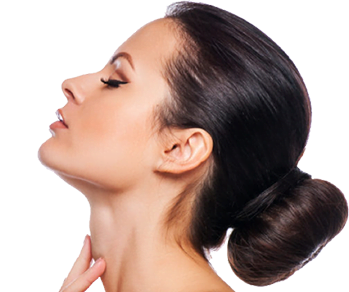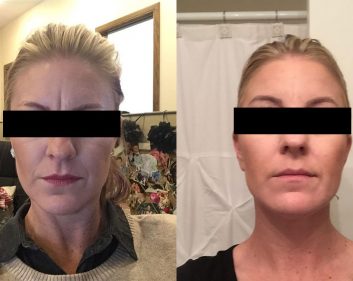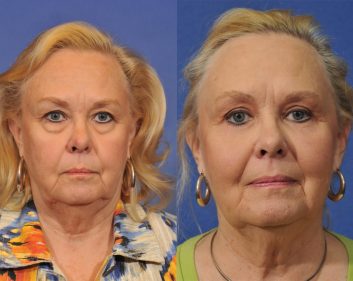Jesse E. Smith, M.D., F.A.C.S
A Colleyville & Fort Worth neck lift specialist, Dr. Smith is Board Certified by the American Board of Facial Plastic and Reconstructive Surgery. He is one of a small group of surgeons that has achieved Dual Board Certification in Facial Plastic and Reconstructive Surgery as well as Head and Neck Surgery.
Colleyville – 817-503-2442
Fort Worth – 817-806-4245
Neck Lift in Fort Worth & Colleyville
Why Consider a Neck Lift?
Have you ever looked in the mirror and used your fingers to elevate the skin and structures of your neck? Did you like what you saw because it reminded you of a more youthful-looking you? If you answered yes, you may be a candidate for facial or neck rejuvenation. You may also be pleasantly surprised to find that you may not need surgery to look younger.
The sagging skin and structures around your neck can add years to your appearance. Aging affects four key components of your face and neck: skin, muscle, bone, and fat. Every person has a different mix of these factors, and correcting them requires each one to be addressed in a special way.
At our offices in Colleyville and Fort Worth, Dr. Jesse E. Smith offers surgical and non-surgical solutions tailored to your unique aging factors.
Non-Surgical Rejuvenation Options
Four components of the face and neck change with age: skin, muscle, bone, and fat. Skin loses elasticity and luster, bone loses volume, and muscles and ligaments become weak, contributing to a sagging appearance. Many surgeons have attempted to alleviate these problems with lifts alone; however, the primary issue can be volume loss that needs to be restored. Dr. Smith offers a variety of in-office treatments at both Colleyville and Fort Worth locations, such as:
- Fat Grafting
- Sculptra
- Juvaderm
- Radiesse
- Restylane
These non-surgical methods can effectively restore volume, offering a lift to your face and neck. Correcting volume loss alone can take years off of a person’s appearance, and we commonly use these products in combination to produce the Liquid Facelift and neck lift. The Liquid Facelift restores volume to hollows, while lifting the cheeks, jowls, temples, and forehead, thus, restoring a natural, youthful appearance to the face and neck.
Traditional vs. Advanced Neck Lifting Techniques
Until recently, most neck lifting techniques consisted of extensions of skin-only lifts, which resulted in a somewhat unnatural and un-refreshed appearance that seemed to be “pulled too much.” While traditional neck lifts focused primarily on skin lifting, resulting in an unnatural “pulled” appearance, Dr. Jesse E. Smith employs modern techniques for more natural results. Beneath the surface of the skin runs a thin sheet of muscle called the superficial musculoaponeurotic system, or SMAS. This forms a critical support network for the face and neck and actually stretches with time, leading to laxity of the overlying skin. The effects of gravity result in drooping of the facial skin because of decreased elasticity and stretching of the underling structures. Surgeries with “SMAS plication” techniques (also known as “S” lift or “J” lift) yield somewhat better results than simple skin lifting in most individuals.
The Crucial Role of SMAS
In most patients though, a “deep plane” neck lift will provide the most natural appearing results. The Superficial Musculoaponeurotic System (SMAS) is a thin layer of muscle providing critical support to the face and neck. Dr. Smith’s techniques often involve elevation of the SMAS, with release of all tethering ligaments. After the SMAS is free, it can be lifted and reset to a more youthful height, and the fad pads that descended with time are elevated and set back into their position as well. This offers a more complex, yet advanced, approach compared to traditional skin-only lifts. The same amount of skin is excised during a deep plane neck lift; however, during closure the tension on the skin is less, making scaring less apparent. Since the underlying structures are elevated and repositioned to a more youthful position, there is a minimal possibility for the “wind tunnel” look of older style lifts, and minimal scarring because there is less wound tension.
Opt for a Deep Plane Neck Lift
Deep plane neck lifting is more technically challenging and not all surgeons feel comfortable with this technique. For the most natural and lasting results, Dr. Jesse E. Smith specializes in deep plane neck lifts. This advanced surgical option is available at both our Colleyville and Fort Worth offices. The recovery time is slightly longer than with simple skin-only lifts or their cousin, the mini-lift or lunchtime lift. The results, however, are more natural and long-lived.
Though technically challenging and with a slightly longer recovery time, deep plane neck lifts performed by Dr. Smith offer the most natural and long-lasting results.
Minimally Invasive Procedures for Younger Patients
Recently, the use of small cameras, through camouflaged incisions within the hairline and inside the mouth, has allowed for effective, minimally-invasive lifts to be performed. These allow for enhancement of the central neck, making it an ideal procedure for the patient in his or her 40s and early 50s. Endoscopic techniques are often combined with rejuvenation of other facial features as well.
A Tailored Approach for Each Patient
Often combinations of the above techniques are needed to turn back the clock in a natural, long-lasting manner, making modern face-lifting techniques quite gratifying for the patient. Dr. Jesse E. Smith believes in offering a personalized treatment plan, tailored to your unique needs.
Get in touch to learn more or schedule a consult at our office in Colleyville or Fort Worth.
Your journey to a younger-looking you starts today!




